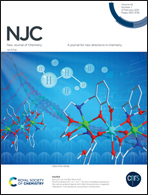An electrochemical platform for the selective detection of azathioprine utilizing a screen-printed carbon electrode modified with manganese oxide/reduced graphene oxide†
Abstract
The long-term use of the immunosuppressive drug, azathioprine (AZT), has been linked to a higher risk of certain cancers; hence, its effective detection is necessary. Recently, the use of transition metal/metal oxide-based materials has attracted intense interest in the field of electrochemistry in combination with carbon materials. Here, we fabricate and demonstrate the use of manganese oxide nanoparticle-decorated reduced graphene oxide modified screen-printed carbon electrodes (Mn2O3–rGO/SPCE) for the electrochemical determination of AZT. The structural, functional, and morphological characteristics of the composite material were evaluated using various analytical tools. The crystalline structure of the synthesized Mn2O3 nanoparticles is identified as orthorhombic with a crystallite size of 20 nm. The existence of sphere-shaped nanoparticles on the rGO sheets and the component elements are confirmed using field emission scanning electron microscopy (FESEM) and energy dispersive X-ray analysis (EDAX). The fabricated electrode (Mn2O3–rGO/SPCE) possesses high electrical conductance, as proved by electrochemical impedance spectroscopy, with an Rct value of 90 Ω. When compared with other electrodes, the Mn2O3–rGO/SPCE has a higher conductive behavior with a wide surface area and a boosted electron transfer, which in turn promotes the effective sensing of AZT. Differential pulsed voltammetry studies (DPV) revealed that the modified electrode possesses a lower limit of detection of about 4 nM, and a sensitivity of almost 7.7 μA μM−1 cm−2, evaluated for a linear range from 0.009 μM to 573.5 μM. Repeatability and reproducibility studies exhibited a relative standard deviation (RSD) value of about 4.96% and 4.89%. Selectivity studies proved that the proposed sensor showed good selective detection in the presence of relevant interfering compounds. The fabricated Mn2O3–rGO modified SPCE would be an efficient sensor for real-time sensing of AZT because of its effective performance with human blood serum and urine samples.



 Please wait while we load your content...
Please wait while we load your content...